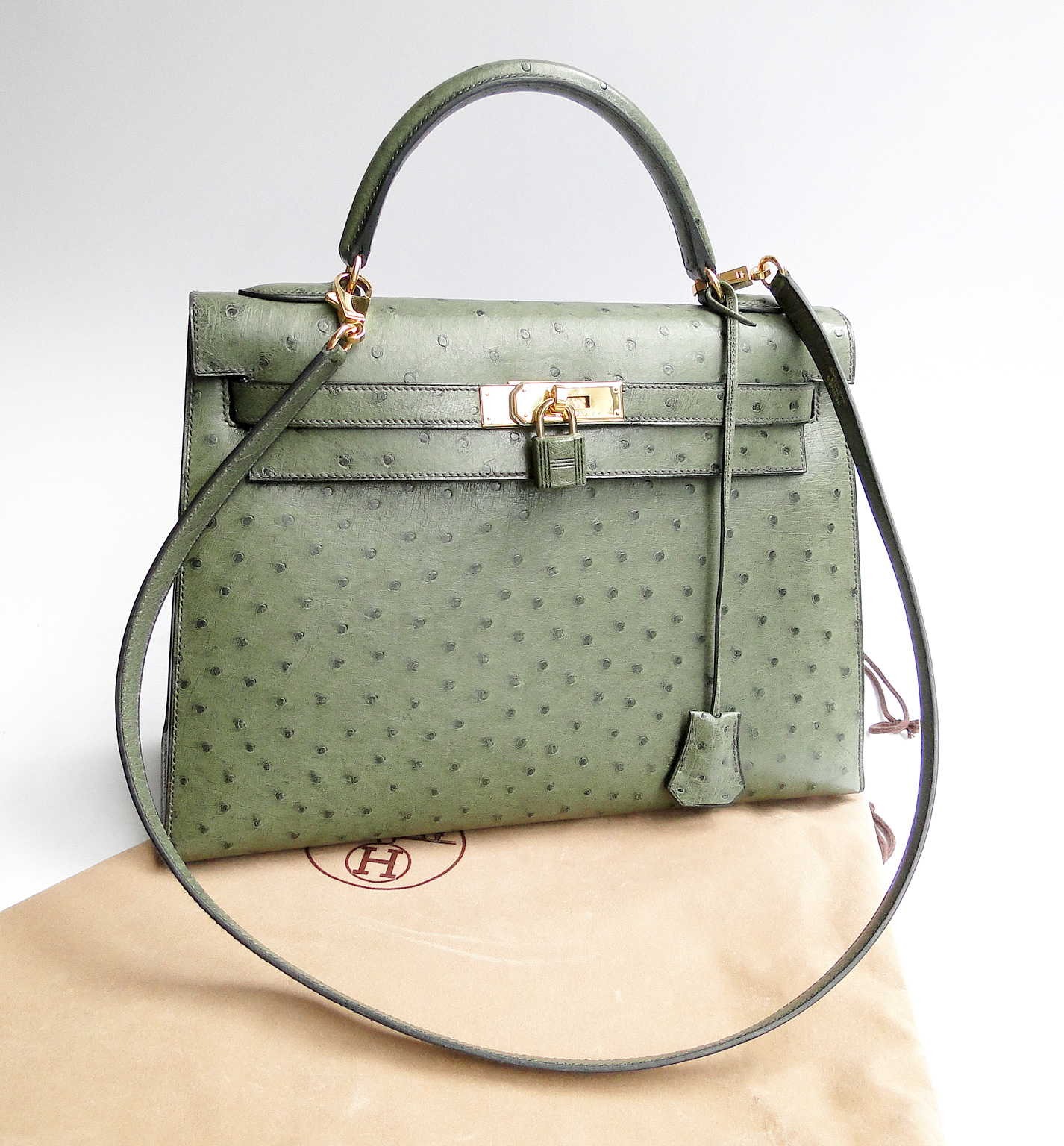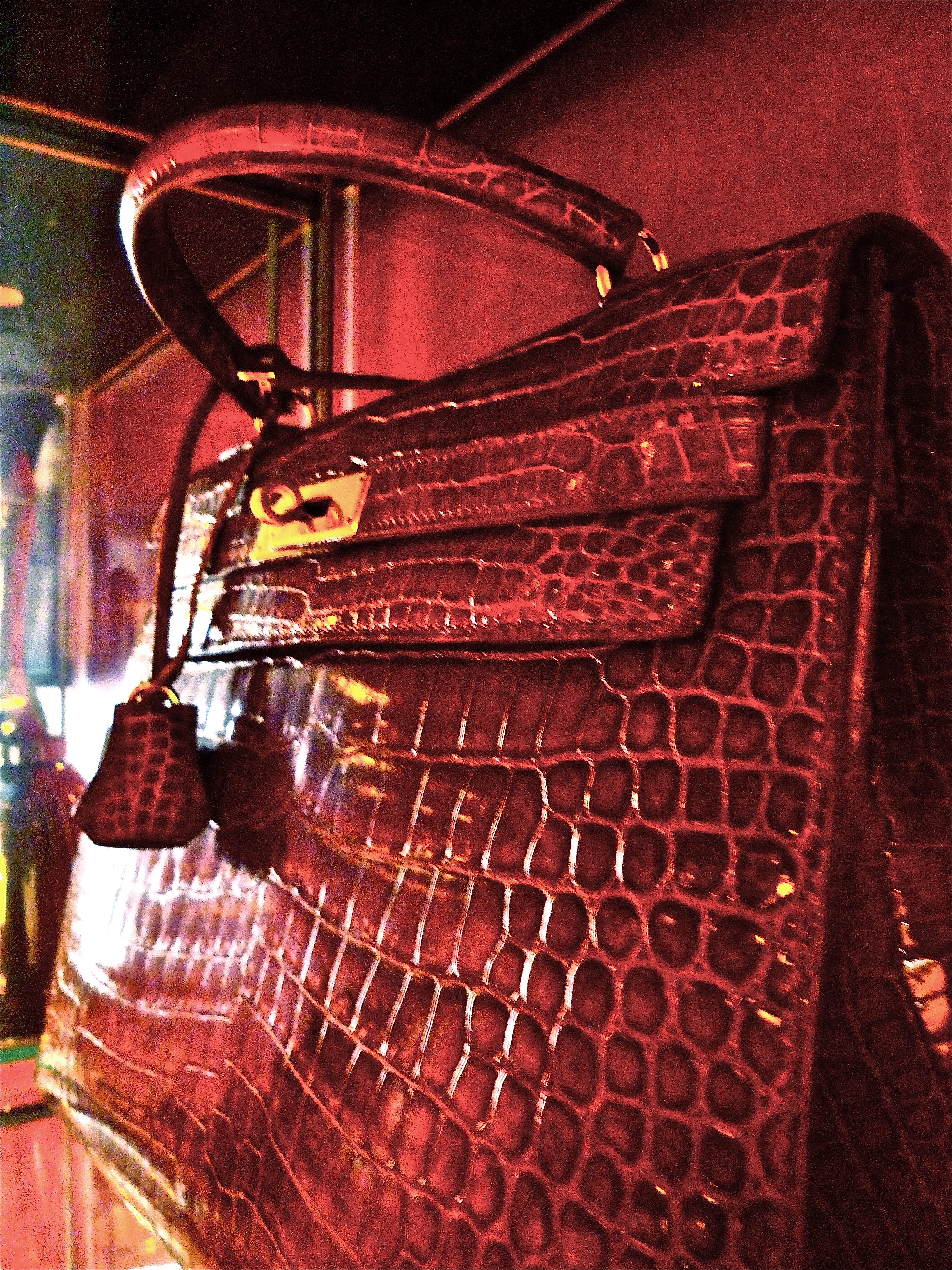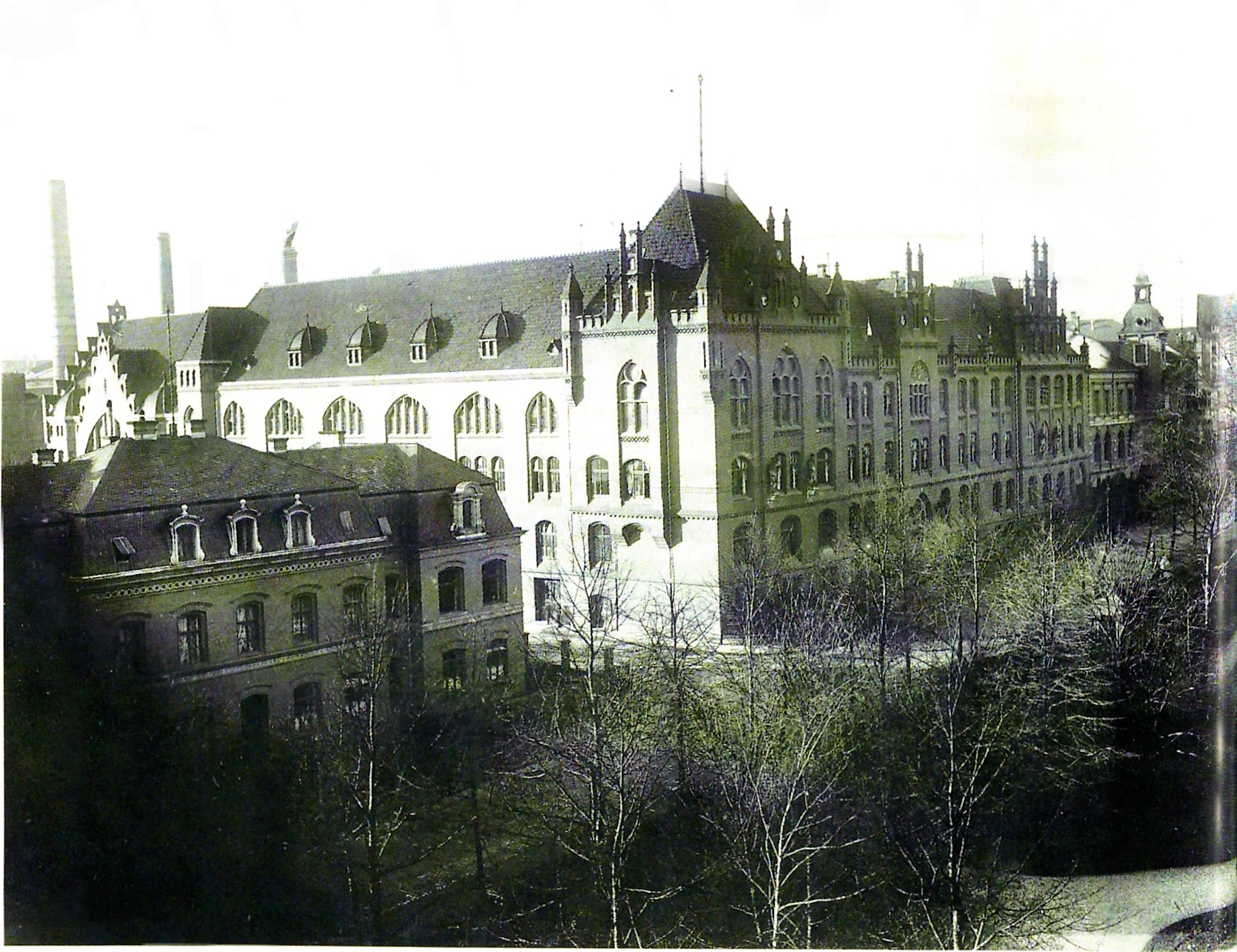|
Ostrich Leather
Bag «Classic» Braun. Ostrich leather is the result of tanning skins taken from African ostriches farmed for their feathers, skin and meat. The leather is distinctive for its pattern of bumps or vacant quill follicles, ranged across a smooth field in varying densities. It requires an intricate, specialised and expensive production process making its aesthetic value costly. Although the first commercial farming began in South Africa in 1850, the industry collapsed after World War I and the drop in demand for the feathers for fashionable hats and military uniforms. Other products were marketed, with each success battered by world events and droughts until now, when ostrich skin is globally available and seen as a luxury item in high-end demand. Leather came late in the story of ostrich farming but after a tannery was set up onsite, it went on to make an impact in European haute couture and in the US for cowboy boots becoming widespread during the 1970s. Demand peaked in the 1980s. ... [...More Info...] [...Related Items...] OR: [Wikipedia] [Google] [Baidu] |
Tanning (leather)
Tanning is the process of treating Skinning, skins and Hide (skin), hides of animals to produce leather. A tannery is the place where the skins are processed. Tanning hide into leather involves a process which permanently alters the protein structure of skin, making it more durable and less susceptible to decomposition and coloring. Before tanning, the skins are dehaired, degreased, desalted and soaked in water over a period of six hours to two days. Historically this process was considered a noxious or "odoriferous trade" and relegated to the outskirts of town. Historically, tanning used tannin, an acidic chemical compound from which the tanning process draws its name, derived from the bark of certain trees. An alternative method, developed in the 1800s, is chrome tanning, where chromium salts are used instead of natural tannins. History The English word for tanning is from medieval Latin , derivative of (oak bark), from French (tanbark), from old-Cornish (red oak). ... [...More Info...] [...Related Items...] OR: [Wikipedia] [Google] [Baidu] |
Kelly Bag
The Kelly bag (formerly known as the Sac à dépêches in 1935) is a leather handbag designed by the Paris-based, high-fashion luxury-goods manufacturer Hermès. The bag was redesigned several times before it was popularized by and then named after the American actress and Monégasque princess Grace Kelly. The bag is now an expensive status symbol. Design The Kelly bag is a trapezium closed around the mouth with two horizontal straps. Four studs on the bottom, itself made of three layers of leather, enable it to stand on the ground. It is sold in eight sizes, ranging from to . The padlock, keys and hardware are made of white or yellow gold. The current model Kelly bag, the Kelly II, comes in two distinct styles, as did its predecessor, the Kelly I. The ''sellier'' style is a rigid construction including a stiffening layer between the outer leather and inner lining, with the side and bottom stitching clearly visible; the ''retourné'' style is a softer construction, wherein th ... [...More Info...] [...Related Items...] OR: [Wikipedia] [Google] [Baidu] |
Botswana
Botswana (, ), officially the Republic of Botswana ( tn, Lefatshe la Botswana, label=Setswana, ), is a landlocked country in Southern Africa. Botswana is topographically flat, with approximately 70 percent of its territory being the Kalahari Desert. It is bordered by South Africa to the south and southeast, Namibia to the west and north, and Zimbabwe to the northeast. It is connected to Zambia across the short Zambezi River border by the Kazungula Bridge. A country of slightly over 2.3 million people, Botswana is one of the most sparsely populated countries in the world. About 11.6 percent of the population lives in the capital and largest city, Gaborone. Formerly one of the world's poorest countries—with a GDP per capita of about US$70 per year in the late 1960s—it has since transformed itself into an upper-middle-income country, with one of the world's fastest-growing economies. Modern-day humans first inhabited the country over 200,000 years ago. The Tswana ethnic ... [...More Info...] [...Related Items...] OR: [Wikipedia] [Google] [Baidu] |
Namibia
Namibia (, ), officially the Republic of Namibia, is a country in Southern Africa. Its western border is the Atlantic Ocean. It shares land borders with Zambia and Angola to the north, Botswana to the east and South Africa to the south and east. Although Kazungula, it does not border Zimbabwe, less than 200 metres (660 feet) of the Botswanan right bank of the Zambezi, Zambezi River separates the two countries. Namibia gained independence from South Africa on 21 March 1990, following the Namibian War of Independence. Its capital and largest city is Windhoek. Namibia is a member state of the United Nations (UN), the Southern African Development Community (SADC), the African Union (AU) and the Commonwealth of Nations. The driest country in sub-Saharan Africa, Namibia has been inhabited since pre-historic times by the San people, San, Damara people, Damara and Nama people. Around the 14th century, immigration, immigrating Bantu peoples arrived as part of the Bantu expansion. Since ... [...More Info...] [...Related Items...] OR: [Wikipedia] [Google] [Baidu] |
Zimbabwe
Zimbabwe (), officially the Republic of Zimbabwe, is a landlocked country located in Southeast Africa, between the Zambezi and Limpopo Rivers, bordered by South Africa to the south, Botswana to the south-west, Zambia to the north, and Mozambique to the east. The capital and largest city is Harare. The second largest city is Bulawayo. A country of roughly 15 million people, Zimbabwe has 16 official languages, with English, Shona language, Shona, and Northern Ndebele language, Ndebele the most common. Beginning in the 9th century, during its late Iron Age, the Bantu peoples, Bantu people (who would become the ethnic Shona people, Shona) built the city-state of Great Zimbabwe which became one of the major African trade centres by the 11th century, controlling the gold, ivory and copper trades with the Swahili coast, which were connected to Arab and Indian states. By the mid 15th century, the city-state had been abandoned. From there, the Kingdom of Zimbabwe was established, fol ... [...More Info...] [...Related Items...] OR: [Wikipedia] [Google] [Baidu] |
Chromium(III) Sulfate
Chromium(III) sulfate usually refers to the inorganic compounds with the formula Cr2(SO4)3.x(H2O), where x can range from 0 to 18. Additionally, ill-defined but commercially important "basic chromium sulfates" are known. These salts are usually either violet or green solids that are soluble in water. It is commonly used in tanning leather. Chromium(III) sulfates Three chromium(III) sulfates are well characterized: *Anhydrous chromium(III) sulfate, Cr2(SO4)3, (CAS #10101-53-8) is a violet solid that dissolves in water upon addition of a reducing agent, which generates chromium(II) sulfates. *Hydrated chromium(III) sulfate, Cr2(SO4)3·18H2O, (CAS #13520-66-6) is a violet solid that readily dissolves in water to give the metal aquo complex, r(H2O)6sup>3+. The formula of this compound can be written more descriptively as r(H2O)6sub>2(SO4)3·6H2O. Six of the eighteen water molecules in this formula unit are water of crystallization. *Hydrated chromium(III) sulfate, Cr2(SO4)3·15(H2O) ... [...More Info...] [...Related Items...] OR: [Wikipedia] [Google] [Baidu] |
Leather
Leather is a strong, flexible and durable material obtained from the tanning, or chemical treatment, of animal skins and hides to prevent decay. The most common leathers come from cattle, sheep, goats, equine animals, buffalo, pigs and hogs, and aquatic animals such as seals and alligators. Leather can be used to make a variety of items, including clothing, footwear, handbags, furniture, tools and sports equipment, and lasts for decades. Leather making has been practiced for more than 7,000 years and the leading producers of leather today are China and India. Animal rights groups claim that modern commercial leather making and the consumption of its products is unethically killing animals. According to the life-cycle assessment (LCA) report for the United Nations Industrial Development Organization, 99% of the raw hides and skins used in the production of leather derive from animals raised for meat and/or dairy production. Critics of tanneries claim that they engage in uns ... [...More Info...] [...Related Items...] OR: [Wikipedia] [Google] [Baidu] |
Head Start (positioning)
A head start is a start in advance of the starting position of others in the competition, or simply toward the finish line or desired outcome. Depending on the situation, a head start may be inherent, obtained by special privilege, earned through one's accomplishments, or granted mercifully by an opponent. While not guaranteeing success, a head start will increase such chances. In sports In competitive sports, such as a race, a head start refers to a start ahead of other competitors, allowing a shorter distance to the finish line. The idea of a head start may seem unfair. But in some cases, a head start is an advantage that may be earned by one more of the competitors. Also, adults who are racing against children may provide children with a head start, knowing the children are slower, and wanting to allow them a chance to win. In multiple-event or multiple-day competitions, such as the modern pentathlon, the final event may use a head start where the leader of the competition ... [...More Info...] [...Related Items...] OR: [Wikipedia] [Google] [Baidu] |
Monopoly
A monopoly (from Greek language, Greek el, μόνος, mónos, single, alone, label=none and el, πωλεῖν, pōleîn, to sell, label=none), as described by Irving Fisher, is a market with the "absence of competition", creating a situation where a specific person or company, enterprise is the only supplier of a particular thing. This contrasts with a monopsony which relates to a single entity's control of a Market (economics), market to purchase a good or service, and with oligopoly and duopoly which consists of a few sellers dominating a market. Monopolies are thus characterized by a lack of economic Competition (economics), competition to produce the good (economics), good or Service (economics), service, a lack of viable substitute goods, and the possibility of a high monopoly price well above the seller's marginal cost that leads to a high monopoly profit. The verb ''monopolise'' or ''monopolize'' refers to the ''process'' by which a company gains the ability to raise ... [...More Info...] [...Related Items...] OR: [Wikipedia] [Google] [Baidu] |
Cartel
A cartel is a group of independent market participants who collude with each other in order to improve their profits and dominate the market. Cartels are usually associations in the same sphere of business, and thus an alliance of rivals. Most jurisdictions consider it anti-competitive behavior and have outlawed such practices. Cartel behavior includes price fixing, bid rigging, and reductions in output. The doctrine in economics that analyzes cartels is cartel theory. Cartels are distinguished from other forms of collusion or anti-competitive organization such as corporate mergers. Etymology The word ''cartel'' comes from the Italian word '' cartello'', which means a "leaf of paper" or "placard", and is itself derived from the Latin ''charta'' meaning "card". The Italian word became ''cartel'' in Middle French, which was borrowed into English. In English, the word was originally used for a written agreement between warring nations to regulate the treatment and exchange of p ... [...More Info...] [...Related Items...] OR: [Wikipedia] [Google] [Baidu] |
DeBeers
De Beers Group is an international corporation that specializes in diamond mining, diamond exploitation, diamond retail, diamond trading and industrial diamond manufacturing sectors. The company is active in open-pit, large-scale alluvial and coastal mining. It operates in 35 countries and mining takes place in Botswana, Namibia, South Africa, Canada and Australia. From its inception in 1888 until the start of the 21st century, De Beers controlled 80% to 85% of rough diamond distribution and was considered a monopoly. Competition has since dismantled the complete monopoly; the De Beers Group now sells approximately 29.5% of the world's rough diamond production by value through its global sightholder and auction sales businesses. The company was founded in 1888 by British businessman Cecil Rhodes, who was financed by the South African diamond magnate Alfred Beit and the London-based N M Rothschild & Sons bank. In 1926, Ernest Oppenheimer, a German immigrant to Britain and later ... [...More Info...] [...Related Items...] OR: [Wikipedia] [Google] [Baidu] |





